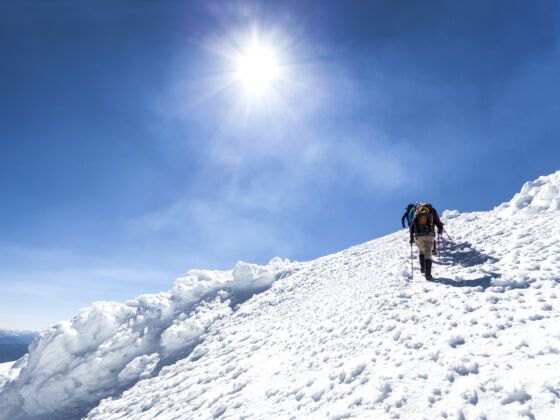An exceptional hike should have some distinctive attribute that makes it memorable. A five-mile stroll through a green tunnel can be a peaceful way to spend an afternoon, but as soon as you throw in a waterfall or a trail that hugs the edge of a cliff, it quickly becomes something much more noteworthy. Nothing meets the criteria more than summiting a volcano. Whether active or dormant, a volcanic hike is anything but your typical walk in the woods. There are plenty of opportunities to hike volcanoes around the world, but here are three unbelievable volcano hikes in the Western Hemisphere that will blow you away (not literally, hopefully):


1. Cerro Chato: Costa Rica
Hiking to the top of Cerro Chato in La Fortuna, Costa Rica provides visitors with the unique opportunity to take a dip inside a volcano. My wife and I did this hike on our honeymoon a couple years ago and it was far and away one of the highlights of the trip. The travel agents in the area will push the idea of doing this hike with a tour guide which can get expensive, but we would recommend taking a taxi to the trailhead, paying the nominal entrance fee, and climbing without a guide. That being said, the hike takes about 4-5 hours round-trip and is quite steep. Not to mention it is in a rainforest, so chances are that it will be raining heavily the entire time. If you’re willing to deal with some steep inclines and constant heavy rain, the reward of swimming in a volcanic crater is well worth it, and will certainly be more memorable than swimming in the pool at your resort. On a clear day, you will have a nice view of the entire water-filled crater from a vantage point at the summit; however, even on a viewless foggy day (which is more likely) the feeling of swimming in the crater lagoon is extremely eerie. If you’re concerned about getting boiled alive, the volcano hasn’t erupted for over 3,500 years, so the odds are in your favor.
2. Volcan Villarica: Chile
Volcano Villarica is exactly what you think of when you think of a volcano. It’s the stereotypical snow-capped cone with smoke billowing from the perfectly symmetrical peak. Upon arriving in the mountain town of Pucon, Chile back in 2011, I asked our taxi driver if the volcano is always this active. He replied, “No, there is more smoke than usual this week.” This obviously wasn’t the response I was hoping for the day before climbing to the top of this active volcano. The following morning, we met our tour group and were transported to the base of the 9,380-foot mountain to begin the ascent. The first leg of the 5-hour climb was dry and rocky, but the terrain quickly transitioned from rock to ice as we gained elevation. At this point we were instructed to take out the helmets, crampons, and ice axes from the packs provided to us by the tour group and we made the final push to the summit over. The views of the surrounding lakes and neighboring volcanoes were spectacular but hearing the magma bubbling below us as we stood on the edge of the volcanic crater almost made us forget about the views. The rising smoke prevented us from actually catching a glimpse of the magma, but the gurgling noise was unmistakable, and to be honest, a bit unsettling.
The worst part of any hike is the descent. You’re tired, you’ve already accomplished the goal of reaching the summit, and the last thing you want to do is retrace your steps in the opposite direction while the cartilage in your knees slowly gets obliterated. You think to yourself, “if only there was a slide that could take me back to the bottom of this mountain.” Well, Villarica has exactly that. There is a series of channels dug into the ice through which hikers get to slide down the majority of the mountainside. It can get a little bit out of control so you have to use the ice ax at times to prevent yourself from flying over the lip of the channel. Just as a side note, Villarica erupted 2015. Hopefully that doesn’t dissuade anyone from attempting this incredible hike.
3. Mt. Pelee: Martinique
Mt. Pelee, located on the French Caribbean island of Martinique, is the third deadliest volcano in recorded history. The eruption in 1902 completely wiped out the city of St. Pierre, killing over 30,000 people in the process. The only survivor was a prisoner who was ironically saved by his poorly-ventilated jail cell. The 4,583-foot Mt. Pelee is one of the most prominent features on the island and a very popular hike among visitors. The hike takes anywhere from 2-4 hours round trip, and includes a steep descent into the volcano’s muddy crater. Since the mountain is almost always shrouded in fog, it is best to start the hike as early as possible in order to take advantage of the views from the summit. Even still, there is no guarantee that there will be unobstructed views since the mountain is a cloud magnet. We never even caught a glimpse of the summit during our week on the island. Views or not, the trail along the edge of the massive crater is stunning.
All three of these hikes can be done in a single day and each one offers a completely unique volcano experience. Whether you want to swim in a volcano, slide down one, or just admire the views from the summit, you’ll find what you’re looking for with one of these three hikes.